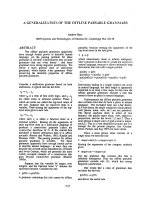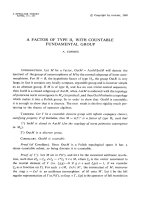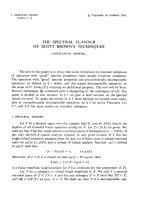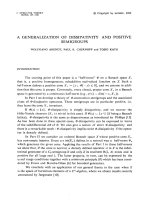Báo cáo toán học: "A DETERMINANT OF THE CHUDNOVSKYS GENERALIZING THE ELLIPTIC FROBENIUS-STICKELBERGER-CAUCHY DETERMINANTAL IDENTITY" ppt
Bạn đang xem bản rút gọn của tài liệu. Xem và tải ngay bản đầy đủ của tài liệu tại đây (103.79 KB, 3 trang )
A DETERMINANT OF THE CHUDNOVSKYS
GENERALIZING THE ELLIPTIC FROBENIUS-STICKELBERGER-CAUCHY
DETERMINANTAL IDENTITY
Tewodros Amdeberhan
Mathematics, DeVry Institute of Technology, North Brunswick, NJ 08902, USA
,
Submitted: October 16, 2000. Accepted: October 23, 2000.
D.V. Chudnovsky and G.V. Chudnovsky [CH] introduced a generalization of the Frobenius-
Stickelberger determinantal identity involving elliptic functions that generalize the Cauchy determinant.
The purpose of this note is to provide a simple essentially non-analytic proof of this evaluation. This method
of proof is inspired by D. Zeilberger’s creative application in [Z1].
AMS Subject Classification: Primary 05A, 11A, 15A
One of the most famous alternants is the Cauchy determinant which is only a special case of a
determinant with symbolic entries:
(1) det
1
x
i
− y
j
1≤i,j≤n
=(−1)
n(n−1)/2
i<j
(x
i
− x
j
)(y
i
− y
j
)
n
i=1
n
j=1
(x
i
− y
j
)
.
This expression lends itself to explicit formulas in Pad´e approximation theory and further applications
in transcendental theory. On the other hand, the Cauchy determinant cannot be readily generalized to
trigonometric or elliptic functions. However, its associate can.
A natural elliptic generalization of the 1/x Cauchy kernel to the corresponding Riemann surface
would be the Weierstraß ζ-function. Such a generalization was supplied by Frobenius and Stickelberger
[FS], with references given to Euler and Jacobi.
D.V. Chudnovsky and G.V. Chudnovsky [CH] introduced a generalization of the Frobenius Stickel-
berger determinantal identity involving elliptic functions that generalizes the Cauchy determinant.
The purpose of this note is to provide a simple essentially non-analytic proof of this evaluation. This
method of proof is inspired by D. Zeilberger’s creative application in [Z1].
We begin by recalling some notations. Given the Weierstraß elliptic function, ℘(z), then the
Weierstraß ζ-function and σ-function are defined respectively by
(2) ℘(z)=−
d
dz
ζ(z), and ζ(z)=
d
dz
log σ(z).
Typeset by A
M
S-T
E
X
1
2
Theorem [CH]: For arbitrary n ≥ 1wehave
det
σ(u
i
+ v
j
+ e)
σ(u
i
+ v
j
)σ(e)
e
γ
1
u
i
+γ
2
v
j
1≤i,j≤n
(3) =
σ(
u
i
+
v
j
+ e)
i>j
σ(u
i
− u
j
)σ(v
i
− v
j
)
σ(e)
n
i,j=1
σ(u
i
+ v
j
)
e
γ
1
u
i
+γ
2
v
j
,
where u
i
,v
j
and e are arbitrary parameters on the elliptic curve.
First, we prove a lemma (set a = b = 0 to get the result of the theorem).
Lemma: With the additional parameters a and b,wehave
det
σ(u
i+a
+ v
j+b
+ e)
σ(u
i+a
+ v
j+b
)σ(e)
e
γ
1
u
i+a
+γ
2
v
j+b
1≤i,j≤n
(4) =
σ(
u
i+a
+
v
j+b
+ e)
i>j
σ(u
i+a
− u
j+b
)σ(v
i+a
− v
j+b
)
σ(e)
n
i,j=1
σ(u
i+a
+ v
j+b
)
e
γ
1
u
i+a
+γ
2
v
j+b
.
Proof: Let the left and right sides of equation (4) be L
n
(a, b)andR
n
(a, b), respectively. Dodg-
son’s rule [D] (see [Z2] for a bijective proof) for evaluating determinants immediately implies [Z1] the
recurrence Lewis:
X
n
(a, b)=
X
n−1
(a, b)X
n−1
(a +1,b+1)− X
n−1
(a +1,b)X
n−1
(a, b +1)
X
n−2
(a +1,b+1)
holds with X = L. Moreover, the same is true if X = R. Indeed the latter takes the form of a
“three-term recurrence”
σ(A
1
+ A
2
)σ(A
1
− A
2
)σ(A
4
+ A
3
)σ(A
4
− A
3
)=σ(A
4
+ A
1
)σ(A
4
− A
1
)σ(A
3
+ A
2
)σ(A
3
− A
2
)
−σ(A
3
+ A
1
)σ(A
3
− A
1
)σ(A
4
+ A
2
)σ(A
4
− A
2
),(5)
where
y :=
n−1
i=2
(u
a+i
+ v
b+i
),w:= (y + u
a+1
+ u
b+n
)/2,A
1
:= w − u
a+1
,
A
2
:= w − u
a+n
,A
3
:= w + v
b+1
and A
4
:= w + v
b+n
.
Equation (5) is similar to the well-known Jacobi identity on σ-functions (this is due to Weierstraß,
in lectures by Schwarz [S] p. 47):
σ(z + a)σ(z − a)σ(b + c)σ(b − c)+σ(z + b)σ(z − b)σ(c + a)σ(c − a)
+ σ(z + c)σ(z − c)σ(a + b)σ(a − b)=0,
and both equations follow from θ-functions identities or the “parallelogram” identity
(6) ℘(z) − ℘(y)=−
σ(z + y)σ(z − y)
σ(z)
2
σ(y)
2
.
3
In fact, a repeated application of (6) in the former equation leads to a trivial algebraic equation in
cyclic notations
(℘(A
1
) − ℘(A
2
))(℘(A
4
) − ℘(A
3
)) − (℘(A
4
) − ℘(A
1
))(℘(A
3
) − ℘(A
2
))
+(℘(A
3
) − ℘(A
1
))(℘(A
4
) − ℘(A
2
)) = 0.
Since L
n
(a, b)=R
n
(a, b)forn = 1 (trivial!), and n = 2 (check!), it follows by induction that
L
n
(a, b)=R
n
(a, b)forall n.
References
[CH] D.V. Chudnovsky, G.V. Chudnovsky, Hypergeometric and modular function identities, and new rational approxi-
mations and continued fraction expansions of classical constants and functions, Contemporary Math. 143 (1993),
117-162.
[D] C.L. Dodgson, Condensation of Determinants, Proc. Royal Soc. of London 15 (1866), 150-155.
[FS] F. Frobenius, L. Stickelberger, Uber die Addition und Multiplication der elliptischen Functionen,F.Frobenius,
Gesammelte Abhandlungen, B. I (1968), Springer, New York, 612-650.
[S] H.A.Schwarz,Formeln und Lehrs¨atze zum Gebrauche der elliptichen Funktionen, Vorlesungen und Aufzeichnungen
des Herrn Prof. K. Weierstrass, Berlin, 1893.
[Z1] D. Zeilberger,, Reverend Charles to the aid of Major Percy and Fields Medalist Enrico, Amer. Math. Monthly 103
(1996), 501-502.
[Z2] D. Zeilberger,, Dodgson’s Determinant-Evaluation Rule Proved by TWO-TIMING MEN and WOMEN, Elec. J.
Comb. [Wilf Festchrifft] 4 (2) #R22 (1997).

![Báo cáo khoa học: A dimer of the FeS cluster biosynthesis protein IscA from cyanobacteria binds a [2Fe2S] cluster between two protomers and transfers it to [2Fe2S] and [4Fe4S] apo proteins ppt](https://media.store123doc.com/images/document/14/rc/tl/medium_tlm1396203606.jpg)







